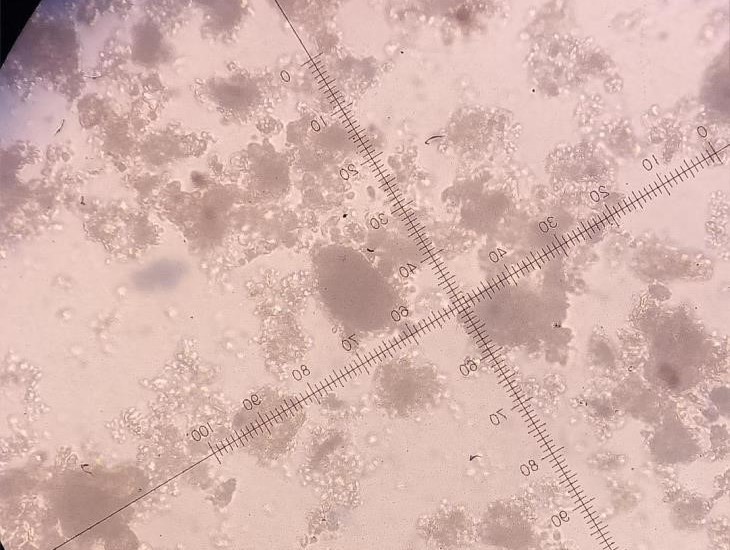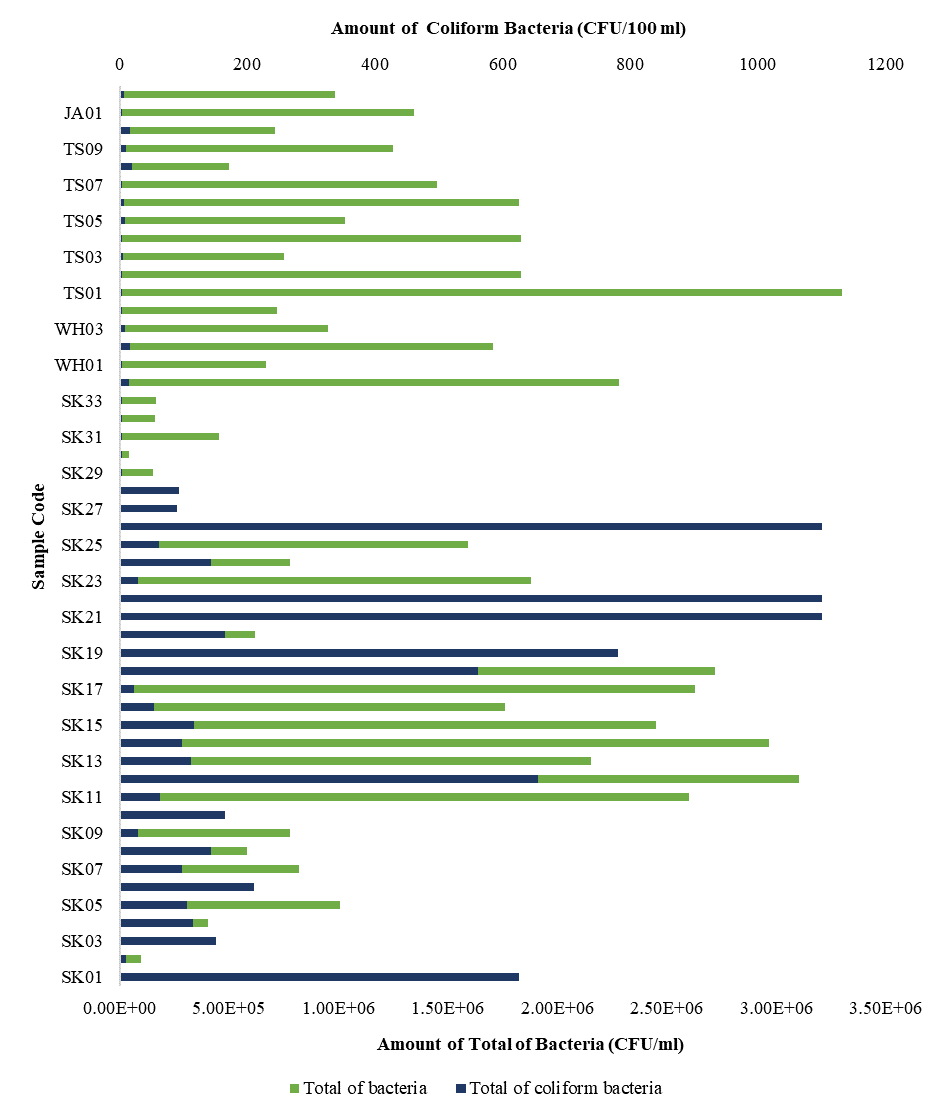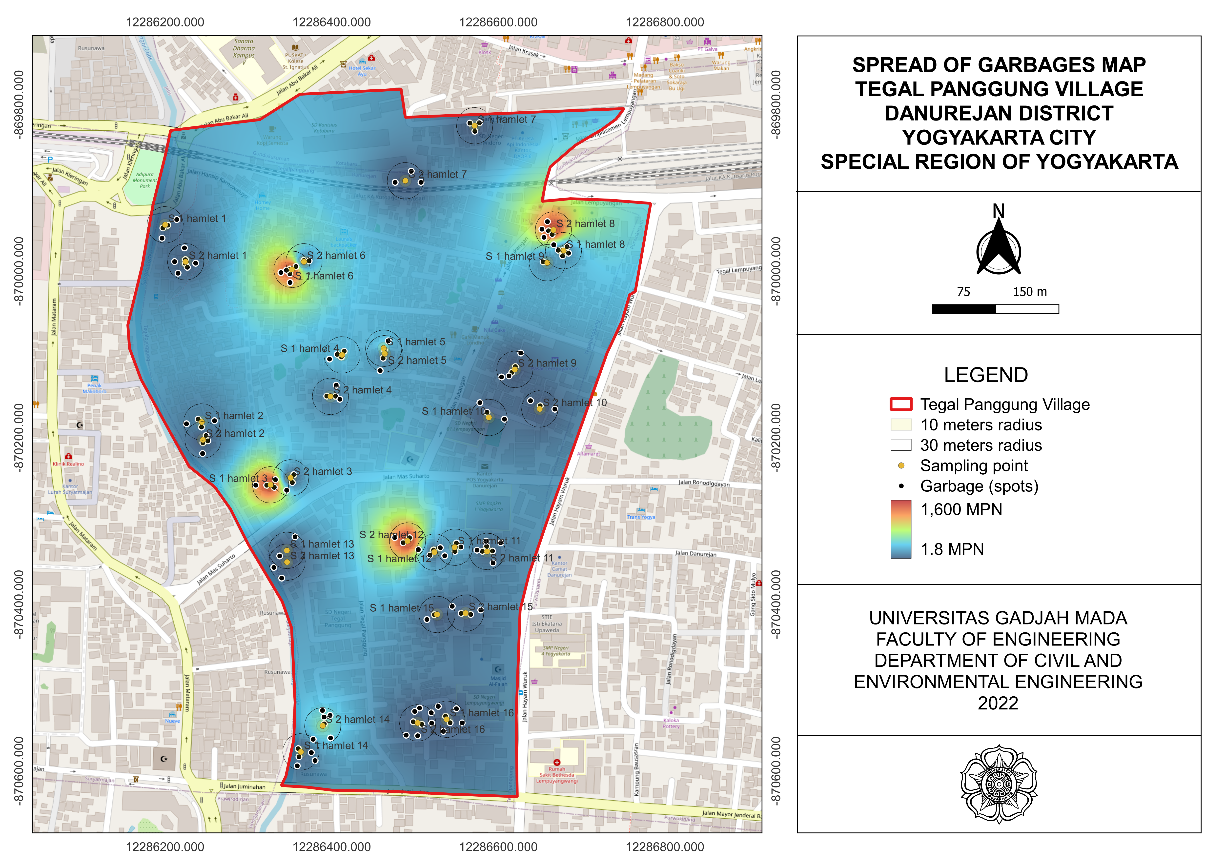The Efficiency of Ascaris Spp. Eggs Inactivation in Sewage Sludge by Lime Dosage, Ammonia Concentration, and Temperature Variation

Introduction:Ascaris spp. eggs threaten sludge reuse because they are usually more environmentally resistant than other microorganisms. Consequently, the WHO recommended an acceptable limit of <1 helminth egg per gram of total solid as a health-based target for treated feces and fecal sludge and aimed to ascertain the effectiveness and reduction rate of Ascaris spp. eggs in sludge at various lime doses, ammonia concentrations, and temperature values. Methods: Eggs were detected and enumerated using the flotation and sedimentation principle. The reduction process was performed in batches with quick lime doses of 30% and 50% w/w, ammonia concentrations of 1,000 and 5,000 mg/L, and temperatures of 30°C and 50°C. Results and Discussion: The number of eggs of Ascaris spp. fertile in the ponds was 1.38 ± 1.38 eggs/gram to 42.98 ± 13.09 eggs/gram, and the infertile amount was 0.46 ± 0.80 eggs/gram to 17.82 ± 6.55 eggs/gram. Using a temperature of 40°C, 50% CaO, and 5,000 ppm ammonia resulted in the highest percentage of reduction, 97.98 - 98.09% but 1.12 eggs/gram was remaining. Conclusion: Higher pH and ammonia levels primarily affect egg decrease in Ascaris spp. To reduce 99% of Ascaris spp. eggs until it reaches <1 egg/g, a dose of 50% CaO is required, with 5,000 ppm ammonia at a temperature of 40°C for 2.7 hours.
Aryanti D. Pengaruh Pengomposan Limbah Lumpur IPAL Domestik dengan Karakteristik Fisik-Kimia dan Logam Berat Kompos. Prosiding Hasil Penelitian Dosen Universitas Ibn Khaldun Bogor. 2020;1(1): 333–44. http://pkm.uika-bogor.ac.id/index.php/prosiding/article/view/655
Amoah ID, Adegoke AA, Stenström TA. Soil-transmitted Helminth Infections Associated with Wastewater and Sludge Reuse: A Review of Current Evidence. Tropical Med Int Heal. 2018;23(7):692–703. http://doi.org/10.1111/tmi.13076
World Health Organization. Guidelines for the Safe Use of Wastewater, Excreta and Greywater. Geneva: World Health Organization; 2006. https://www.who.int/publications/i/item/9241546859
Wang M, Zhu J, Mao X. Removal of Pathogens in Onsite Wastewater Treatment Systems: A Review of Design Considerations and Influencing Factors. Water. 2021;13:1–30. http://doi.org/10.3390/w13091190
Else KJ, Keiser J, Holland CV, Grencis RK, Sattelle DB, Fujiwara RT, et al. Whipworm and roundworm Infections. Nature Rev Dis Prim. 2020;6(1):1–23. https://doi.org/10.1038/s41572-020-0171-3
Manga M, Camargo-valero MA, Evans BE. Inactivation of Viable Ascaris Eggs during Faecal Sludge Co-Composting with Chicken Feathers and Market Waste. Desalination and Water Treatment. 2019;163(1):347–357. https://doi.org/10.5004/dwt.2019.24494
Silver ZA, Kaliappan SP, Samuel P, Venugopal S, Kang G, Sarkar R, et al. Geographical Distribution of Soil Transmitted Helminths and the Effects of Community Type in South Asia and South East Asia – A Systematic Review. PLOS Neglected Trop Dis. 2018;1(1)1–13. http://dx.doi.org/10.1371/journal.pntd.0006153
Asaolu SO, Ofoezie IE. Global Water Pathogen Project, Part Three, Specific Excreted Pathogens: Environmental and Epidemiology Aspects - Ascaris spp. Michigan: Michigan State University; 2018. http://www.waterpathogens.org/book/Ascaris
Tirtawening Regional Water Utility Company. IPAL Bojongsoang. Bandung: Tirtawening Regional Water Utility Company; 2018. p. https://perumdatirtawening.co.id/
Amoah ID, Reddy P, Seidu R, Axel T. Concentration of Soil-Transmitted Helminth Eggs In Sludge from South Africa and Senegal : A Probabilistic Estimation of Infection Risks Associated with Agricultural Application. Journal Environ Manag. 2018;206:1020–1027. https://doi.org/10.1016/j.jenvman.2017.12.003
World Health Organization. Bench Aids for the Diagnosis of Intestinal Parasites, 2nd edition. Geneva: World Health Organization; 2019. https://www.who.int/publications/i/item/9789241515344
World Health Organization. Integrated Guide to Sanitary Parasitology. Amman, Jordan: World Health Organization; 2004. https://apps.who.int/iris/handle/10665/116408
Trasia RF. Current Finding of Helminth Morphology Cause Infectious Disease. Jurnal Al Azhar Indones Seri Sains dan Teknol. 2021;6(2):76–81. http://doi.org/10.36722/sst.vii.692
Shabrina HM, Muntalif BS, Firdayati M, Fathuna IS. Deteksi dan Kuantifikasi Telur Cacing Ascaris spp. Pada Air Limbah dan Lumpur IPAL Bojongsoang Bandung. J Sains dan Teknol Lingkung. 2021;13(1):62–75. https://doi.org/10.20885/jstl.vol13.iss1.art6
Abagale FK, Osei RA. Diversity Profiling of Helminth Eggs in Waste Stabilisation Ponds in the Tamale Metropolis, Ghana. Ghana J Sci Technol Dev. 2021;7(2):1–11. https://doi.org/10.47881/255.967x
Fels LE, Hayany BE, Faiz AE, Saadani M, Houari M. Sludge Nematodes, Cestodes, and Trematodes Eggs Variation from Lagooning, Activated Sludge and Infiltration-Percolation Wastewater Treatment System Under Semi-Arid Climate. Environmental Sci Pollut Res. 2019;26(1):570–576. https://doi.org/10.1007/s11356-018-3618-2
Sabbahi S, Ayed LB, Trad M, Berndtsson R, Karanis P. Parasitological Assessment of Sewage Sludge Samples for Potential Agricultural Reuse in Tunisia. International J Environ Res Public Heal. 2022;19(3):1–18. https://doi.org/10.3390/ijerph19031657
Muntalif BS, Firdayati M, Lesmono FD, Siregar ASV, Notodarmojo PA, Fathuna IS. Helminth Eggs Assessment of Fecal Sludge in Urban Area of Bandung, Indonesia. In: E3S Web of Conferences. 2020;1(1):1–6. https://doi.org/10.1051/e3sconf/202014804002
Sklyarova V, Shatylovich K, Sklyarov P, Filipyuk A. Should Ascariasis be Considered as a Reproductology Problem?. Wiadomosci Lek. 2021;LXXIV(9 p.1):2138–2146. https://doi.org//10.36740/WLek202109120
Mahapatra S, Ali MH, Samal K, Moulick S. Diagnostic and Treatment Technologies for Detection and Removal of Helminth in Wastewater and Sludge. Energy Nexus. 2022;8(100147):1–16. https://doi.org/10.1016/j.nexus.2022.100147
Castellanos-rozo J, Galvis-lópez JA, Merchán-castellanos NA, Salcedo-reyes JC. Assessment of Two Sludge Stabilization Methods in a Wastewater Treatment Plant in Sotaquirá, Colombia. Javeriana. 2020;25(1):17–36. https://doi.org/10.11144/Javeriana.SC25-1.aots
Teleshova EN, Petuhova EA. Study of the Effect of Quicklime on the Sludge Treatment and Dehydration. In: IOP Conf Series: Earth and Environmental Science. 2021;852(1):1–5. https://doi.org/10.1088/1755-1315/852/1/012103
Mraz AL, Tumwebaze IK, McLoughlin SR, McCarthy ME, Verbyla ME, Hofstra N, et al. Why Pathogens Matter for Meeting the United Nations' Sustainable Development Goal 6 on Safely Managed Water and Sanitation. Water Res. 2021;189(1165591):1-8. https://doi.org/10.1016/j.watres.2020.116591
Maya C, Pérez M, Velásquez G, Barrios JA, Román A, Jiménez B. Quick Incubation Process to Determine Inactivation of Ascaris and Toxocara eggs. Water Sci Technol. 2019;80(12):2328–2338. https://doi.org/10.2166/wst.2020.062
An-nori A, El Fels L, Ezzariai A, El Hayani B, El Mejahed K, El Gharous M, et al. Effectiveness of Helminth Egg Reduction by Solar Drying and Liming of Sewage Sludge. Environmental Sci Pollut Res. 2021;28(12):14080–14091. https://doi.org/10.1007/s11356-020-11619-w
Harroff LA, Liotta JL, Bowman DD, Angenent LT. Current Time-Temperature Relationships for Thermal Inactivation of Ascaris Eggs at Mesophilic Temperatures are Too Conservative and May Hamper Development of Simple, But Effective Sanitation. Water Res X. 2019;5(100036):1–7. https://doi.org/10.1016/j.wroa.2019.100036
Aboamer MM, Mohamed AH, Osman GY, Rahman EHA, El Shanawany EE. Inactivation of Toxocara vitulorum eggs by Ammonia in Combination with Solar Energy. Egypt J Aquat Biol Fish. 2019;23(4):201–214. http://dx.doi.org/10.21608/ejabf.2019.52938
Senecal J, Nordin A, Vinneras B. Fate of Ascaris at Various pH, Temperature and Moisture Levels. Journal Water Heal. 2020;18(3):375–382. https://doi.org/10.2166/wh.2020.264
Khadra A, Ezzariai A, Kouisni L, Hafidi M. Helminth Eggs Inactivation Efficiency by Sludge Co-Composting Under Arid Climates. International J Environ Heal Res. 2019;31(5):530–537. https://doi.org/10.1080/09603123.2019.1671960
Musaazi IG, McLoughlin S, Murphy HM, Rose JB, Hofstra N, Tumwebaze IK, et al. A Systematic Review and Meta-Analysis of Pathogen Reduction in Onsite Sanitation Systems. Water Res X. 2023;18(100171):1–12. https://doi.org/10.1016/j.wroa.2023.100171

This work is licensed under a Creative Commons Attribution-NonCommercial-ShareAlike 4.0 International License.
1. Copyright of all journal manuscripts is held by the Jurnal Kesehatan Lingkungan.2. Formal legal provisions to access digital articles of electronic journal are subject to the provision of the Creative Commons Attribution-ShareAlike license (CC BY-NC-SA), which means that Jurnal Kesehatan Lingkungan is rightful to keep, transfer media/format, manage in the form of databases, maintain, and publish articles.
3. Published manuscripts both printed and electronic are open access for educational, research, and library purposes. Additionally, the editorial board is not responsible for any violations of copyright law.
JKESLING by UNAIR is licensed under a Creative Commons Attribution-ShareAlike 4.0 International License.







































